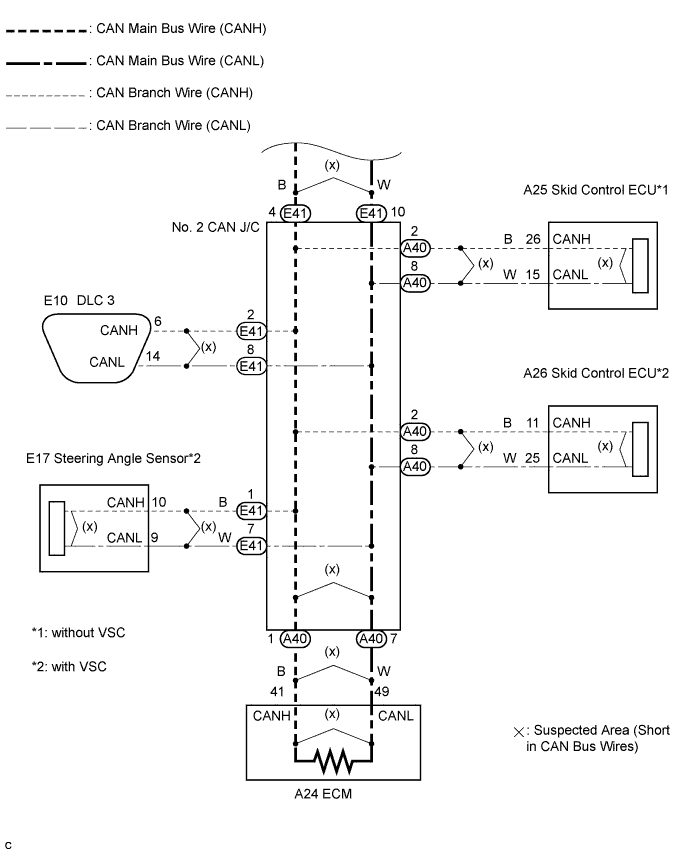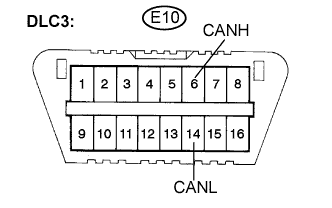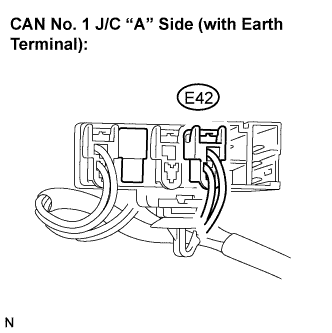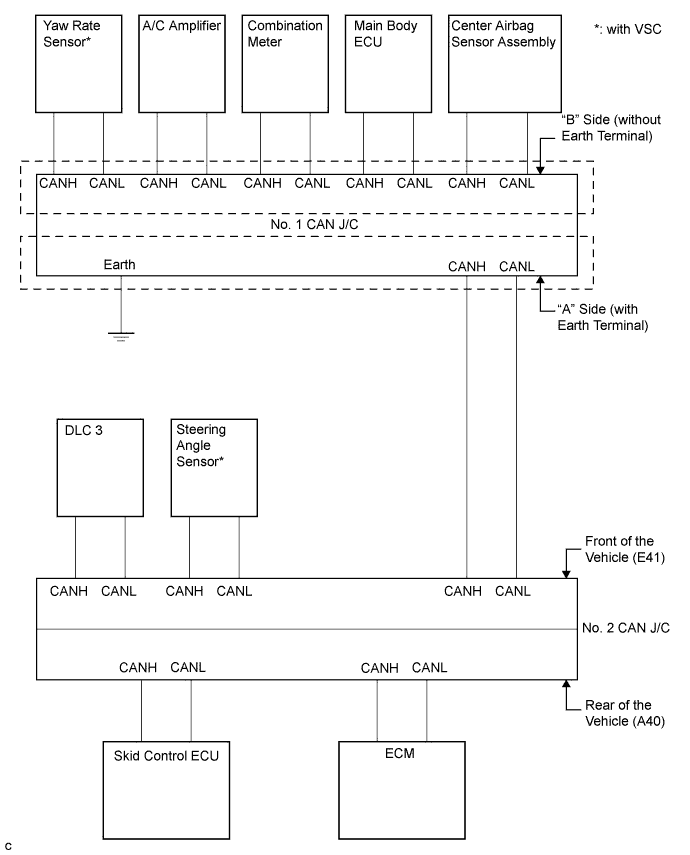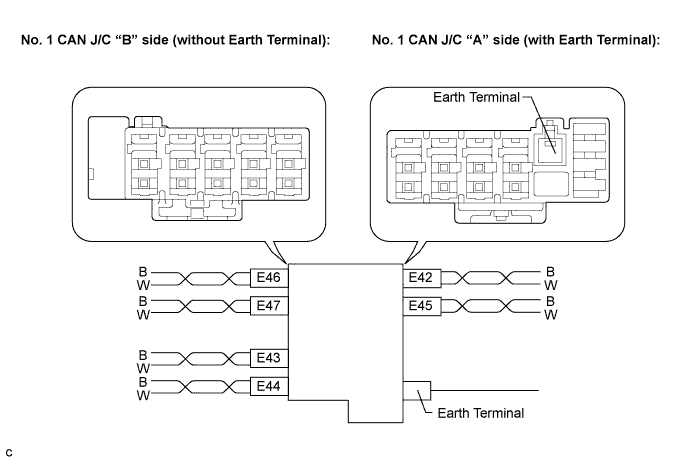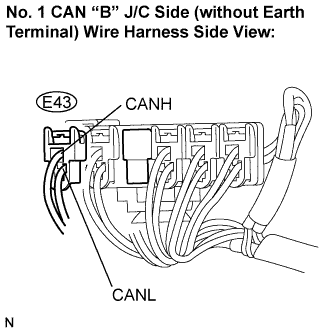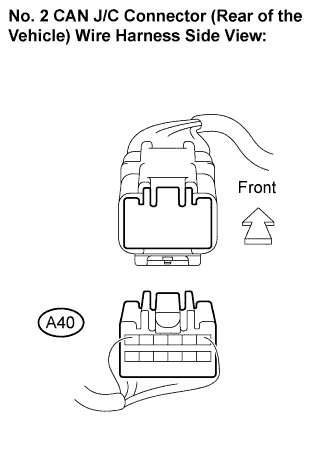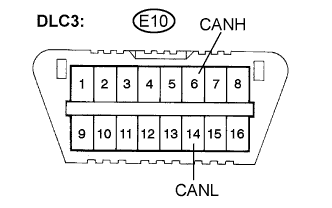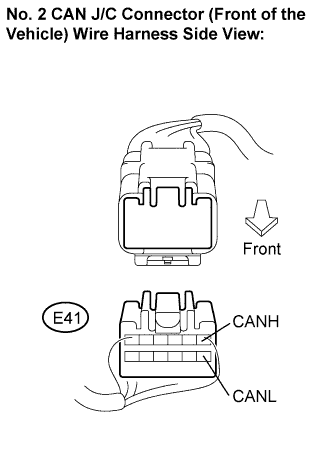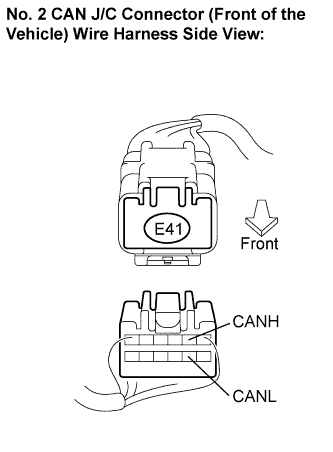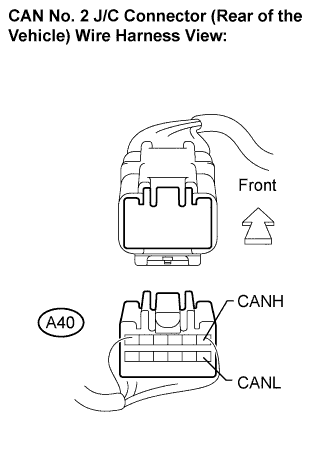DESCRIPTION
WIRING DIAGRAM
INSPECTION PROCEDURE
CHECK FOR SHORT IN CAN BUS WIRES (DLC3 BRANCH WIRE)
CHECK FOR SHORT IN CAN BUS WIRES (NO. 1 CAN J/C SIDE)
CHECK FOR SHORT IN CAN BUS WIRES (NO. 1 CAN J/C BRANCH WIRE)
CHECK FOR SHORT IN CAN BUS WIRES (COMBINATION METER MAIN BUS WIRE)
RECONNECT CONNECTOR
CHECK FOR SHORT IN CAN BUS WIRES (COMBINATION METER)
CHECK FOR SHORT IN CAN BUS WIRES (NO. 1 CAN J/C - NO. 2 CAN J/C)
CHECK FOR SHORT IN CAN BUS WIRES (STEERING ANGLE SENSOR BRANCH WIRE)
CHECK FOR SHORT IN CAN BUS WIRES (NO. 1 CAN J/C - NO. 2 CAN J/C)
CHECK FOR SHORT IN CAN BUS WIRES (STEERING ANGLE SENSOR - NO. 2 CAN J/C)
CHECK FOR SHORT IN CAN BUS WIRES (ECM MAIN BUS WIRE)
CHECK FOR SHORT IN CAN BUS WIRES (SKID CONTROL ECU - NO. 2 CAN J/C)
CHECK FOR SHORT IN CAN BUS WIRES (ECM MAIN BUS WIRE)
RECONNECT CONNECTOR
CHECK FOR SHORT IN CAN BUS WIRES
CAN COMMUNICATION SYSTEM (for RHD) - Short in CAN Bus Lines |
DESCRIPTION
The CAN bus wires are considered to be shorted when the resistance between terminals 6 (CANH) and 14 (CANL) of the DLC3 is below 54 Ω.Symptom
| Trouble Area
|
Resistance between terminals 6 (CANH) and 14 (CANL) of the DLC3 is below 54 Ω.
| - Short in CAN bus wires
- Skid control ECU
- Steering angle sensor
- Yaw rate sensor
- ECM
- Main body ECU
- A/C amplifier
- Center airbag sensor assembly
- Combination meter
- No. 1 CAN J/C
- No. 2 CAN J/C
|
WIRING DIAGRAM
INSPECTION PROCEDURE
- NOTICE:
- Turn the ignition switch off before measuring the resistance of the CAN main wire and CAN branch wires.
- After the ignition switch is turned off, check that the key reminder warning system and lighting system are not operating.
- Before measuring the resistance, leave the vehicle as is for at least 1 minute and do not operate the ignition switch, any other switches or the doors. If doors need to be opened in order to check connectors, open the doors and leave them open.
- HINT:
- Operating the ignition switch, any other switches or any triggers related ECU and sensor communication on the CAN, which would cause resistance reading variations.
| 1.CHECK FOR SHORT IN CAN BUS WIRES (DLC3 BRANCH WIRE) |
Turn the ignition switch off.
Disconnect the DLC3 branch wire connector (E41) from the No. 2 CAN J/C (front of the vehicle).
Measure the resistance according to the value(s) in the table below.
- Standard resistance:
Tester Connection
| Condition
| Specified Value
|
E10-6 (CANH) - E10-14 (CANL)
| Ignition switch off
| 1 MΩ or higher
|
Reconnect the DLC3 branch wire connector (E41) to the No. 2 CAN J/C (front of the vehicle).
| | REPAIR OR REPLACE DLC3 BRANCH WIRE OR CONNECTOR |
|
|
| 2.CHECK FOR SHORT IN CAN BUS WIRES (NO. 1 CAN J/C SIDE) |
Disconnect the CAN main bus wire connector (E42) from the No. 1 CAN J/C "A" side (with earth terminal).
Connect the probes of an ohmmeter to terminals 6 (CANH) and 14 (CANL) of the DLC3.
Measure the resistance according to the value(s) in the table below.
- Standard resistance:
Tester Connection
| Condition
| Specified Value
|
E10-6 (CANH) - E10-14 (CANL)
| Ignition switch off
| 108 to 132 Ω
|
| 3.CHECK FOR SHORT IN CAN BUS WIRES (NO. 1 CAN J/C BRANCH WIRE) |
Reconnect the CAN main bus wire connector (E42) to the No. 1 CAN J/C "A" side (with earth terminal).
Connect the probes of an ohmmeter to terminals 6 (CANH) and 14 (CANL) of the DLC3.
While observing the resistance value shown on the tester, disconnect connectors E44, E45, E46 and E47 from the No. 1 CAN J/C one by one until the resistance becomes normal (between 54 and 69 Ω).
- HINT:
- Disconnect the branch wire connectors other than those of the DLC3.
CAN J/C connectors ("A" side, with earth terminal)
| Connector Color
| Wire Color (CAN-H)
| Wire Color (CAN-L)
|
Airbag Sensor Assembly Center (E45)
| Black
| B
| W
|
CAN J/C connectors ("B" side, with earth terminal)
| Connector Color
| Wire Color (CAN-H)
| Wire Color (CAN-L)
|
Yaw Rate Sensor (E46)*
| Blue
| B
| W
|
A/C Amplifier (E47)
| Gray
| B
| W
|
Main Body ECU (E44)
| Black
| B
| W
|
*: with VSC
- NOTICE:
- Do not reconnect the disconnected connectors until this inspection is complete because there may be a short in 2 or more branch wires.
- Result:
Symptom
| Proceed to
|
The resistance is still below 54 Ω when all the specified connectors are disconnected. (There are no shorts in the branch wires.)
| A
|
The resistance becomes normal (between 54 and 69 Ω) when a connector is disconnected. (There is a short in one or more of the branch wires.)
| B
|
When there is a short in one or more of the branch wires:
Reconnect all of the connectors to the No. 1 CAN J/C, except for the one that was disconnected last (the short-circuited bus wire). Check that the resistance shown on the tester is normal (between 54 and 69 Ω) to confirm that there is a short in one branch wire only.
- HINT:
- The connectors connected to the No. 1 CAN J/C can be distinguished according to the color of the communication bus wires and the shape of the connectors.
- Reconnecting the connectors to non-specified positions on the No. 1 CAN J/C does not affect system operation. However, it is preferred to reconnect the connectors to their specified positions to avoid negative effects on the wiring such as tension on the wiring harnesses, and to make future maintenance easier.
| 4.CHECK FOR SHORT IN CAN BUS WIRES (COMBINATION METER MAIN BUS WIRE) |
Disconnect the combination meter main bus wire connector (E43) from the No. 1 CAN J/C "B" side (without earth terminal).
- NOTICE:
- Before disconnecting the connector, make a note of where it is connected.
- Reconnect the connector to its original position.
Measure the resistance according to the value(s) in the table below.
- Standard resistance:
Tester Connection
| Condition
| Specified Value
|
E10-6 (CANH) - E10-14 (CANL)
| Ignition switch off
| 108 to 132 Ω
|
Reconnect the combination meter main bus wire connector (E43) to the No. 1 CAN J/C "A" side (with earth terminal).
| 6.CHECK FOR SHORT IN CAN BUS WIRES (COMBINATION METER) |
Disconnect the combination meter connector (F1).
Measure the resistance according to the value(s) in the table below.
- Standard resistance:
Tester Connection
| Condition
| Specified Value
|
E10-6 (CANH) - E10-14 (CANL)
| Ignition switch off
| 108 to 132 Ω
|
- HINT:
- If the resistance changes to 108 to 132 Ω or more when the connector is disconnected, there may be a short in the combination meter.
| | REPAIR OR REPLACE CAN BUS MAIN WIRE (COMBINATION METER MAIN BUS WIRE) |
|
|
| OK |
|
|
|
| REPLACE COMBINATION METER |
|
| 7.CHECK FOR SHORT IN CAN BUS WIRES (NO. 1 CAN J/C - NO. 2 CAN J/C) |
Disconnect the No. 2 CAN J/C connector (A40).
Measure the resistance according to the value(s) in the table below.
- Standard resistance:
Tester Connection
| Condition
| Specified Value
|
E10-6 (CANH) - E10-14 (CANL)
| Ignition switch off
| 108 to 132 Ω
|
| 8.CHECK FOR SHORT IN CAN BUS WIRES (STEERING ANGLE SENSOR BRANCH WIRE) |
Reconnect the No. 2 CAN J/C connector (A40).
Disconnect the No. 2 CAN J/C connector (E41).
Measure the resistance according to the value(s) in the table below.
- Standard resistance:
Tester Connection
| Condition
| Specified Value
|
E41-1 (CANH) - E41-7 (CANL)
| Ignition switch off
| 1 MΩ or higher
|
| 9.CHECK FOR SHORT IN CAN BUS WIRES (NO. 1 CAN J/C - NO. 2 CAN J/C) |
Disconnect the No. 2 CAN J/C connector (E41).
Measure the resistance according to the value(s) in the table below.
- Standard resistance:
Tester Connection
| Condition
| Specified Value
|
E41-2 (CANH) - E41-8 (CANL)
| Ignition switch off
| 1 MΩ or higher
|
| | REPAIR OR REPLACE CAN BUS MAIN WIRE OR CONNECTOR (NO. 1 CAN J/C - NO. 2 CAN J/C) |
|
|
| 10.CHECK FOR SHORT IN CAN BUS WIRES (STEERING ANGLE SENSOR - NO. 2 CAN J/C) |
Disconnect the steering angle sensor connector (E17).
Measure the resistance according to the value(s) in the table below.
- Standard resistance:
Tester Connection
| Condition
| Specified Value
|
E41-4 (CANH) - E41-10 (CANL)
| Ignition switch off
| 1 MΩ or higher
|
| | REPAIR OR REPLACE STEERING ANGLE SENSOR BRANCH LINE OR CONNECTOR |
|
|
| OK |
|
|
|
| REPLACE STEERING ANGLE SENSOR |
|
| 11.CHECK FOR SHORT IN CAN BUS WIRES (ECM MAIN BUS WIRE) |
Disconnect the No. 2 CAN J/C connector (A40).
Measure the resistance according to the value(s) in the table below.
- Standard resistance:
Tester Connection
| Condition
| Specified Value
|
A40-1 (CANH) - A40-7 (CANL)
| Ignition switch off
| 1 MΩ or higher
|
| 12.CHECK FOR SHORT IN CAN BUS WIRES (SKID CONTROL ECU - NO. 2 CAN J/C) |
Disconnect the skid control ECU connector (A25 or A26).
Measure the resistance according to the value(s) in the table below.
- Standard resistance:
Tester Connection
| Condition
| Specified Value
|
A40-2 (CANH) - A40-8 (CANL)
| Ignition switch off
| 1 MΩ or higher
|
- HINT:
- Measure the resistance with the No. 2 CAN J/C connector (A40) disconnected.
| NG |
|
|
|
| REPAIR OR REPLACE SKID CONTROL ECU BRANCH WIRE OR CONNECTOR |
|
| 13.CHECK FOR SHORT IN CAN BUS WIRES (ECM MAIN BUS WIRE) |
Disconnect the ECM connector (A24).
Measure the resistance according to the value(s) in the table below.
- Standard resistance:
Tester Connection
| Condition
| Specified Value
|
A40-1 (CANH) - A40-7 (CANL)
| Ignition switch off
| 1 MΩ or higher
|
- HINT:
- Measure the resistance with the No. 2 CAN J/C connector (A40) disconnected.
| | REPAIR OR REPLACE CAN BUS MAIN WIRE (ECM - NO. 2 CAN J/C) |
|
|
Reconnect the connector for the short-circuited branch wire to the No. 1 CAN J/C (the connector that caused the bus wire resistance to become normal (between 54 and 69 Ω) when it was disconnected).
| 15.CHECK FOR SHORT IN CAN BUS WIRES |
Disconnect the connector that includes terminals CANH and CANL from the ECU (or sensor) to which the short-circuited branch wire is connected. (CAMRY_ACV40 RM000000WI803XX.html)
Measure the resistance according to the value(s) in the table below.
- Standard resistance:
Tester Connection
| Condition
| Specified Value
|
E10-6 (CANH) - E10-14 (CANL)
| Ignition switch off
| 54 to 69 Ω
|
- HINT:
- If the resistance becomes normal (between 54 and 69 Ω) when the connector is disconnected from the ECU (or sensor), there may be a short in the ECU (or sensor).
| | REPAIR OR REPLACE CORRESPONDING ECU OR SENSOR BRANCH WIRE OR CONNECTOR |
|
|
| OK |
|
|
|
| REPLACE CORRESPONDING ECU OR SENSOR |
|

